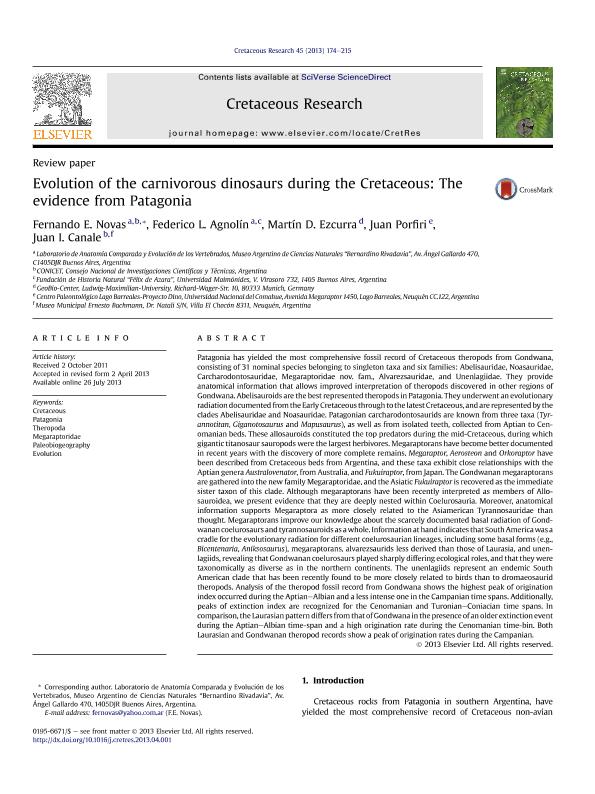Mostrar el registro sencillo del ítem
dc.contributor.author
Novas, Fernando Emilio

dc.contributor.author
Agnolin, Federico

dc.contributor.author
Ezcurra, Martin Daniel

dc.contributor.author
Porfiri, Juan Domingo

dc.contributor.author
Canale, Juan Ignacio

dc.date.available
2020-04-06T15:30:40Z
dc.date.issued
2013-10
dc.identifier.citation
Novas, Fernando Emilio; Agnolin, Federico; Ezcurra, Martin Daniel; Porfiri, Juan Domingo; Canale, Juan Ignacio; Evolution of the carnivorous dinosaurs during the Cretaceous: The evidence from Patagonia; Academic Press Ltd - Elsevier Science Ltd; Cretaceous Research; 45; 10-2013; 174-215
dc.identifier.issn
0195-6671
dc.identifier.uri
http://hdl.handle.net/11336/102037
dc.description.abstract
Patagonia has yielded the most comprehensive fossil record of Cretaceous theropods from Gondwana, consisting of 31 nominal species belonging to singleton taxa and six families: Abelisauridae, Noasauridae, Carcharodontosauridae, Megaraptoridae nov. fam., Alvarezsauridae, and Unenlagiidae. They provide anatomical information that allows improved interpretation of theropods discovered in other regions of Gondwana. Abelisauroids are the best represented theropods in Patagonia. They underwent an evolutionary radiation documented from the Early Cretaceous through to the latest Cretaceous, and are represented by the clades Abelisauridae and Noasauridae. Patagonian carcharodontosaurids are known from three taxa (Tyrannotitan, Giganotosaurus and Mapusaurus), as well as from isolated teeth, collected from Aptian to Cenomanian beds. These allosauroids constituted the top predators during the mid-Cretaceous, during which gigantic titanosaur sauropods were the largest herbivores. Megaraptorans have become better documented in recent years with the discovery of more complete remains. Megaraptor, Aerosteon and Orkoraptor have been described from Cretaceous beds from Argentina, and these taxa exhibit close relationships with the Aptian genera Australovenator, from Australia, and Fukuiraptor, from Japan. The Gondwanan megaraptorans are gathered into the new family Megaraptoridae, and the Asiatic Fukuiraptor is recovered as the immediate sister taxon of this clade. Although megaraptorans have been recently interpreted as members of Allosauroidea, we present evidence that they are deeply nested within Coelurosauria. Moreover, anatomical information supports Megaraptora as more closely related to the Asiamerican Tyrannosauridae than thought. Megaraptorans improve our knowledge about the scarcely documented basal radiation of Gondwanan coelurosaurs and tyrannosauroids as a whole. Information at hand indicates that South America was a cradle for the evolutionary radiation for different coelurosaurian lineages, including some basal forms (e.g., Bicentenaria, Aniksosaurus), megaraptorans, alvarezsaurids less derived than those of Laurasia, and unenlagiids, revealing that Gondwanan coelurosaurs played sharply differing ecological roles, and that they were taxonomically as diverse as in the northern continents. The unenlagiids represent an endemic South American clade that has been recently found to be more closely related to birds than to dromaeosaurid theropods. Analysis of the theropod fossil record from Gondwana shows the highest peak of origination index occurred during the Aptian–Albian and a less intense one in the Campanian time spans. Additionally, peaks of extinction index are recognized for the Cenomanian and Turonian–Coniacian time spans. In comparison, the Laurasian pattern differs from that of Gondwana in the presence of an older extinction event during the Aptian–Albian time-span and a high origination rate during the Cenomanian time-bin. Both Laurasian and Gondwanan theropod records show a peak of origination rates during the Campanian.
dc.format
application/pdf
dc.language.iso
eng
dc.publisher
Academic Press Ltd - Elsevier Science Ltd

dc.rights
info:eu-repo/semantics/openAccess
dc.rights.uri
https://creativecommons.org/licenses/by-nc-sa/2.5/ar/
dc.subject
CRETACEOUS
dc.subject
PATAGONIA
dc.subject
THEROPODS
dc.subject
MEGARAPTORIDAE
dc.subject
PALEOBIOGEOGRAPHY
dc.subject
EVOLUTION
dc.subject.classification
Paleontología

dc.subject.classification
Ciencias de la Tierra y relacionadas con el Medio Ambiente

dc.subject.classification
CIENCIAS NATURALES Y EXACTAS

dc.title
Evolution of the carnivorous dinosaurs during the Cretaceous: The evidence from Patagonia
dc.type
info:eu-repo/semantics/article
dc.type
info:ar-repo/semantics/artículo
dc.type
info:eu-repo/semantics/publishedVersion
dc.date.updated
2020-04-02T15:05:59Z
dc.journal.volume
45
dc.journal.pagination
174-215
dc.journal.pais
Estados Unidos

dc.description.fil
Fil: Novas, Fernando Emilio. Consejo Nacional de Investigaciones Científicas y Técnicas. Oficina de Coordinación Administrativa Parque Centenario. Museo Argentino de Ciencias Naturales "Bernardino Rivadavia"; Argentina
dc.description.fil
Fil: Agnolin, Federico. Consejo Nacional de Investigaciones Científicas y Técnicas. Oficina de Coordinación Administrativa Parque Centenario. Museo Argentino de Ciencias Naturales "Bernardino Rivadavia"; Argentina. Fundación de Historia Natural Félix de Azara; Argentina
dc.description.fil
Fil: Ezcurra, Martin Daniel. Ludwig Maximilians Universitat; Alemania. Consejo Nacional de Investigaciones Científicas y Técnicas. Oficina de Coordinación Administrativa Parque Centenario. Museo Argentino de Ciencias Naturales "Bernardino Rivadavia"; Argentina
dc.description.fil
Fil: Porfiri, Juan Domingo. Universidad Nacional del Comahue. Centro Paleontológico Lago Barreales; Argentina
dc.description.fil
Fil: Canale, Juan Ignacio. Provincia del Neuquén. Municipalidad de Villa El Chocón. Museo Paleontológico "Ernesto Bachmann"; Argentina. Consejo Nacional de Investigaciones Científicas y Técnicas; Argentina
dc.journal.title
Cretaceous Research

dc.relation.alternativeid
info:eu-repo/semantics/altIdentifier/doi/http://dx.doi.org/10.1016/j.cretres.2013.04.001
dc.relation.alternativeid
info:eu-repo/semantics/altIdentifier/url/https://www.sciencedirect.com/science/article/pii/S0195667113000608
Archivos asociados
